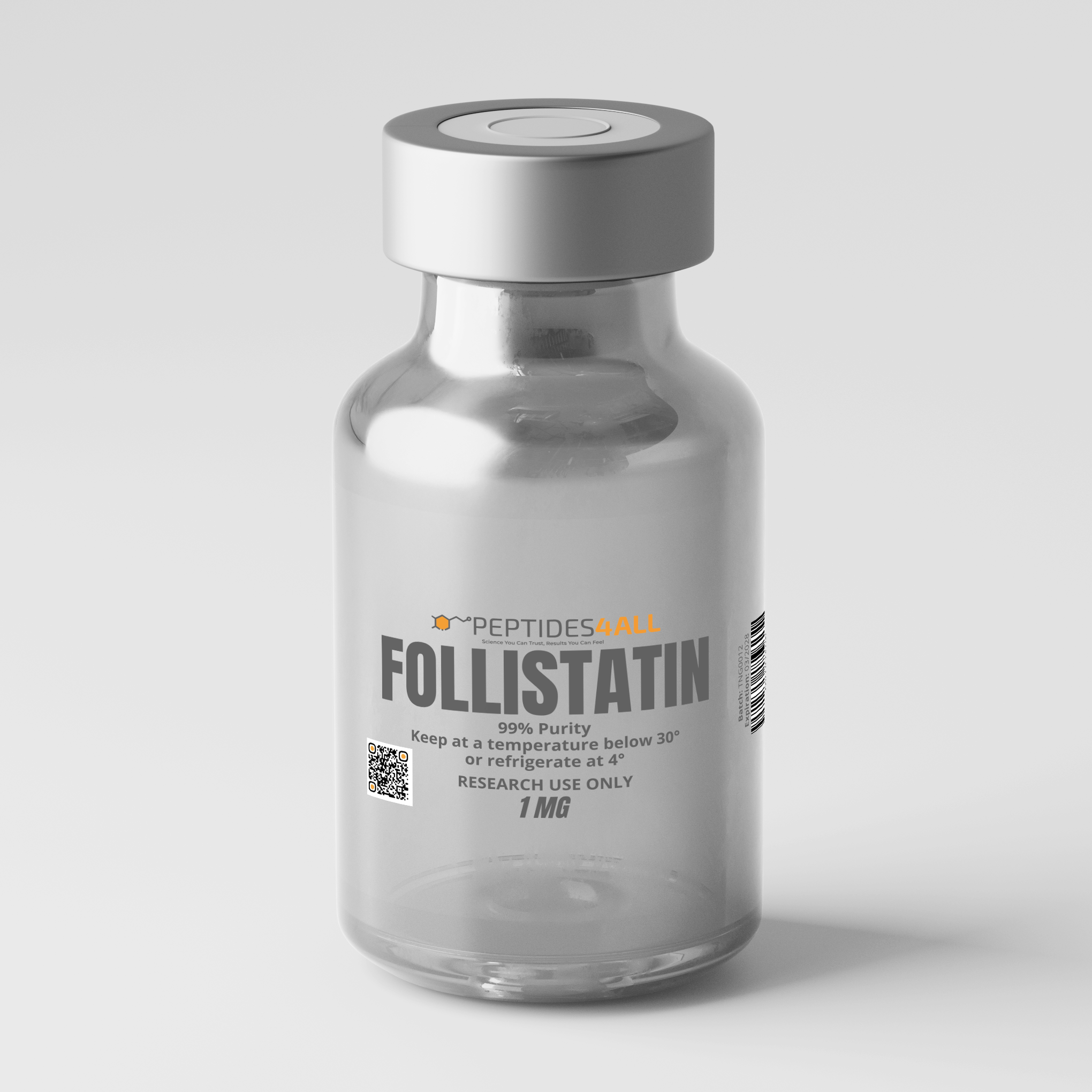PEPTIDES4ALL Follistatin – Myostatin/Activin Inhibitor for Muscle & Regenerative Research
PEPTIDES4ALL Follistatin is a naturally occurring glycoprotein that plays a pivotal role in the regulation of muscle growth, tissue regeneration, and metabolic balance. First identified in the late 1980s as a potent antagonist of activins, Follistatin is expressed in various tissues—particularly in the liver, skeletal muscle, and reproductive organs—where it acts as a key modulator of growth factor signaling. Its most well-characterized function is the inhibition of myostatin (GDF-8), a powerful negative regulator of muscle development. By binding and neutralizing myostatin, Follistatin effectively removes the natural braking mechanism on muscle growth, enabling enhanced muscle hypertrophy, strength, and repair.
Beyond its direct effects on muscle tissue, Follistatin’s broad inhibition of activins extends its research relevance into inflammatory control, fibrosis prevention, and endocrine regulation. Through these pathways, Follistatin has demonstrated potential in restoring lean mass, improving metabolic efficiency, and supporting organ health across multiple preclinical models.
Emerging studies have shown that upregulation or administration of Follistatin can reverse muscle wasting in conditions such as muscular dystrophy and cachexia, while also promoting tissue recovery and anti-fibrotic activity. Its multifaceted actions—spanning from muscle regeneration and fat reduction to cellular protection and metabolic optimization—make it a central molecule of interest in the fields of regenerative medicine, performance physiology, and longevity research.
With its high purity, stability, and biologically active formulation, PEPTIDES4ALL Follistatin offers researchers a reliable tool to investigate myostatin and activin inhibition pathways, advancing the scientific understanding of muscle growth regulation, tissue repair, and systemic metabolic health.
Scientific Evidence & Research Findings
-
Myostatin Inhibition & Muscle Growth – Follistatin binds myostatin (GDF-8) and neutralizes its signaling, enabling significant increases in muscle mass and strength in animal models. https://pmc.ncbi.nlm.nih.gov/articles/PMC2859604/
-
Activin Pathway Modulation – Besides myostatin, follistatin inhibits activins which are involved in inflammation, fibrosis, and metabolic signaling; this broader inhibition may support muscle and organ health. https://www.sciencedirect.com/science/article/abs/pii/S002235652427275X
-
Therapeutic Potential in Muscle Wasting – In dystrophy and cachexia models, increased follistatin expression or administration has reversed muscle loss and improved function. https://www.sciencedirect.com/science/article/abs/pii/S002235652427275X
-
Fat Reduction & Metabolic Effects – By lifting the inhibitory effects of myostatin, follistatin can lead to increased muscle mass (which burns more energy) and reduced fat deposition in experimental settings.
-
Support for Regeneration & Longevity – The combined effects on muscle regeneration, anti-fibrosis, and metabolic balance make follistatin a candidate molecule in regenerative and anti-aging studies.
Key Research Benefits & Applications
-
Myostatin & Activin Inhibition: Potently binds and neutralizes myostatin (GDF-8) and activins, removing inhibitory control over muscle growth and promoting hypertrophy and strength development.
-
Muscle Regeneration & Recovery: Enhances satellite-cell activation, myoblast differentiation, and tissue repair, supporting regeneration following injury, immobilization, or muscle-wasting conditions.
-
Anti-Fibrotic & Organ-Protective Effects: Inhibits activin-driven fibrotic signaling in liver, cardiac, and skeletal tissues, reducing scar formation and improving organ resilience.
-
Metabolic Optimization & Fat Reduction: Increases lean body mass and energy expenditure while reducing adipose tissue, offering a model for studying metabolic efficiency and body-composition regulation.
-
Inflammation & Endocrine Modulation: Balances inflammatory and endocrine pathways influenced by activins, contributing to systemic homeostasis and stress adaptation.
-
Applications in Regenerative & Longevity Research: Serves as a key research model for muscle-growth regulation, tissue regeneration, and anti-aging interventions, bridging metabolic and performance physiology.
Presentation & Handling
- Form: Supplied as lyophilized peptide in sterile vial.
- Reconstitution: Use bacteriostatic water or 2% procaine; swirl gently (do not shake vigorously).
- Storage: Store at –20 °C, protected from light and moisture. After reconstitution, use according to research protocols and handle under sterile conditions.
Intended Use
For research purposes only. Must be handled in accordance with institutional protocols and ethical guidelines.
